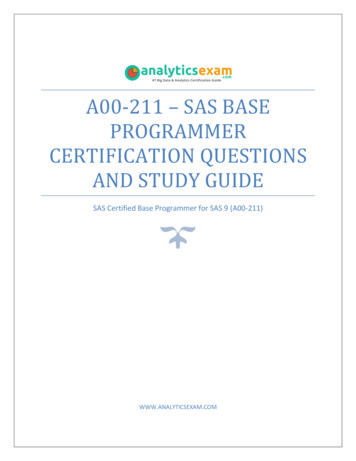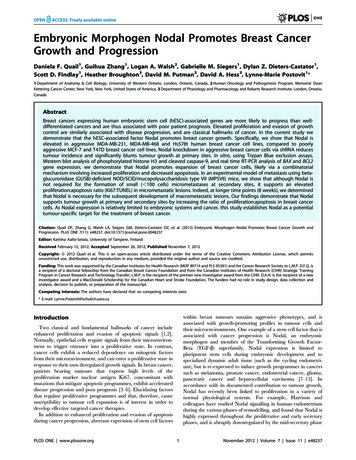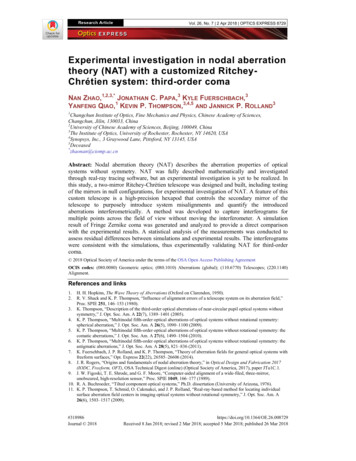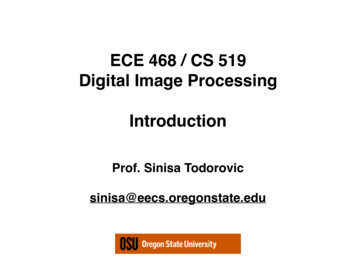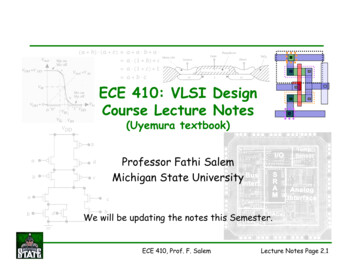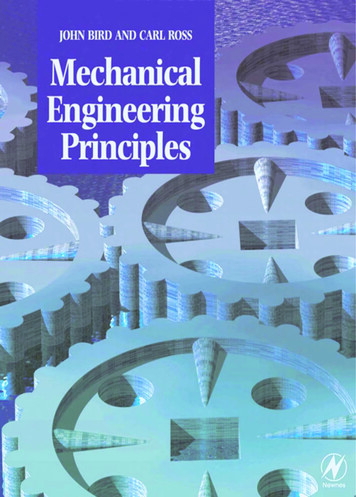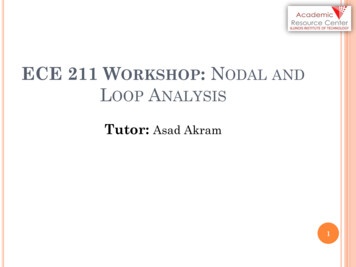
Transcription
ECE 211 WORKSHOP: NODAL ANDLOOP ANALYSISTutor: Asad Akram1
AGENDABackground: KCL and KVL. Nodal Analysis: Independent Sources and relating problems, Dependent Sources and relating problems. Loop (Mesh Analysis):Independent Sources and relating problems, Dependent Sources and relating problems. Practice Problems and solutions.2
KCL AND KVL REVIEWRule: Algebraic sum ofRule: The sum ofelectrical current thatvoltages around amerge in a commonclosed loop circuit isnode of a circuit is zero.equal to zero.3
KCL AND KVL EXAMPLEFind I and Vbd inthe followingcircuit? Solution: Using KCL we know thatonly 1 current I flows inthe loop.Then we apply Ohm’s lawto find the current I.Lastly, we use KVL in thesingle loop to evaluate thevoltage Vbd.We therefore see how KCLand KVL can used assimple analysis tools.4
NODAL ANALYSIS Nodal Analysis of electronic circuits is based onassigning Nodal voltages at various nodes of thecircuit with respect to a reference and thenfinding these nodal voltages to analyze thecircuit.Simple representation of Nodal Voltages shownbelow:As shown in Figure, a node is a pointin a circuit where two or more wiresmeet. At these nodes one can assigna nodal voltage with respect to thereference ground shown.5
NODAL ANALYSIS: INDEPENDENT SOURCES ONLY First we find the number of KCL equations (These are used to findthe nodal voltages). N -1 n, here N number of equations, n number of nodes.Then we write the KCL equations for the nodes and solve them tofind the respected nodal voltages.Once we have these nodal voltages, we can use them to furtheranalyze the circuit.SuperNode: Two Nodes with a independent Voltage sourcebetween them is a Super node and one forms a KVL equation for it.Example1 (Circuit with Ind. Current Sources):Find the Nodal Voltagesin the circuit?6
NODAL ANALYSIS: INDEPENDENT SOURCES ONLYIn this example we write theKCL equations at the nodes asShown, then solve them to findThe respected nodal voltages.7
NODAL ANALYSIS: INDEPENDENT SOURCES ONLYExample2 (Ind. Voltage Sources Only):For this Problem, we first make the mainKCL equation at the only node 1.Current is taken to be coming out of the nodeas positive. We solve this equation to findThe nodal voltage V1.Once this is determined, Io is simply foundby using Ohm’s law at the sole resistor of3KOhm.8
NODAL ANALYSIS: DEPENDENT SOURCES Find Vo using Nodal Analysis?For this Circuit, We need toOverlook the node with dependentSource and form equations roundit. We use KCL at Nodes 1 and 2and derive the equations based onCurrent flow.9
NODAL ANALYSIS: DEPENDENT SOURCESAfter setting up the Nodal Eqn.For dependent Circuits, on hasTo make the Controlling eqn.This equation is made using theDependent source. Using theControlling equation we solveFor the nodal voltages.10
NODAL ANALYSIS: DEPENDENT SOURCESFind Io in the circuit using Nodal Analysis?Using KCL at nodes 2 andForming a controlling equationAt node 1 we can simplify theProblem into simple equations.Current entering the node isSummed at the node to formThe equations.11
NODAL ANALYSIS: DEPENDENT SOURCESSimplify the circuit toObtain nodal voltage.12
MESH ANALYSIS Mesh Analysis involves solving electronic circuitsvia finding mesh or loop currents of the circuit.This is done by forming KVL equations forrespected loops and solving the equations to findindividual mesh currents.We simply assume clockwise current flow inAll the loops and find them to analyze the circuit.Also any independent current source in a loopBecomes the loop current as current in series isSame.13
MESH ANALYSIS: INDEPENDENT SOURCESFind Vo in the circuit?Using KVL at loops 1 and 2, we formKVL equations using the current andComponents in the loops in terms ofThe loop currents.Important thing to look at it theSubtraction of the opposing loopCurrent in the shared section of theLoop.14
MESH ANALYSIS: INDEPENDENT SOURCESThe mesh equations are solvedSimultaneously and the required loopCurrent is found. Then we use this loopCurrent to find Vo in across the resistor.15
MESH ANALYSIS: DEPENDENT SOURCESFind Vo in the circuit using Mesh Analysis?Simplify the circuit using theIndependent sources by assigningThem to the mesh currents forThe specific loop.16
MESH ANALYSIS: DEPENDENT SOURCESForm KVL in Main loop 3. Simplify Using Vx and I2.17
PRACTICE PROBLEMS18
PRACTICE PROBLEMS19
PRACTICE PROBLEMS20
PRACTICE PROBLEMS21
PRACTICE PROBLEMS22
PRACTICE PROBLEMS23
PRACTICE PROBLEMS24
END!!25
SOLUTIONS TO PRACTICE PROBLEMS26
SOLUTIONS TO PRACTICE PROBLEMS27
SOLUTIONS TO PRACTICE PROBLEMS28
SOLUTIONS TO PRACTICE PROBLEMS29
SOLUTIONS TO PRACTICE PROBLEMS30
SOLUTIONS TO PRACTICE PROBLEMS31
SOLUTIONS TO PRACTICE PROBLEMS32
SOLUTIONS TO PRACTICE PROBLEMS33
SOLUTIONS TO PRACTICE PROBLEMS34
SOLUTIONS TO PRACTICE PROBLEMS35
SOLUTIONS TO PRACTICE PROBLEMS36
SOLUTIONS TO PRACTICE PROBLEMS37
SOLUTIONS TO PRACTICE PROBLEMS38
SOLUTIONS TO PRACTICE PROBLEMS39
SOLUTIONS TO PRACTICE PROBLEMS40
Nodal Analysis of electronic circuits is based on assigning Nodal voltages at various nodes of the circuit with respect to a reference and then finding these nodal voltages to analyze the circuit. Simple representation of Nodal Voltages shown below: 5 As shown in Figure, a node is a point in a circuit where two or more wires meet.

